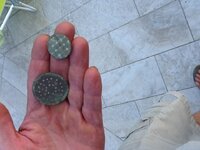Metalguru
Greenie
- May 9, 2014
- 11
- 10
- Detector(s) used
- AT Pro Garrett pin pointer stock coil 5x8 coil& Nel Tornado XP Deus
- Primary Interest:
- Metal Detecting
Hey Cannonballguy , can you work your magic on these? I can see no backmark on either! Thanx






